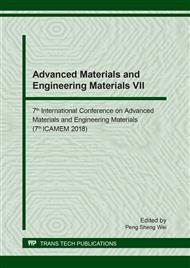[1]
J. Davidovits, Geopolymer chemistry and application, 3rd editon, Institute Geopolymer, France, (2011).
Google Scholar
[2]
H.T. Nguyen, T.K. Pham, M.M.A.B. Abdullah, Lightweight Heat Resistant Geopolymer-based Materials Synthesized from Red Mud and Rice Husk Ash Using Sodium Silicate Solution as Alkaline Activator, MATEC Web Conferences 97 (2017) 011-019.
DOI: 10.1051/matecconf/20179701119
Google Scholar
[3]
H.T. Nguyen, T.K. Pham, M.A.B. Promentilla, Development of Geopolymer-Based Materials from Coal Bottom Ash and Rice Husk Ash with Sodium Silicate Solutions, Lecture Notes in Civil Engineering, 8 (2018) 402-410.
DOI: 10.1007/978-981-10-6713-6_40
Google Scholar
[4]
M.A.B. Promentilla, M.E. Kalaw, H.T. Nguyen, K.B. Aviso, R.R. Tan, A Fuzzy Programming Approach to Multi-Objective Optimization for Geopolymer Product Design, Computer Aided Chemical Engineering, 40 (2017) 1015-1020.
DOI: 10.1016/b978-0-444-63965-3.50171-9
Google Scholar
[5]
M.E.L. Kalaw, A.B. Culaba, H.T. Nguyen, K. Nguyen, H. Hinode, W. Kurniawan, S.M. Gallardo, M.A.B. Promentilla, Mechanical and Thermal Properties of Geopolymers from Mixtures of Coal Ash and Rice Hull Ash using Water Glass Solution as Activator, ASEAN Journal of Chemical Engineering, 15 (2) (2015).
DOI: 10.22146/ajche.49686
Google Scholar
[6]
A.K.R. Sumabat, A.J. Manalac, H.T. Nguyen, M.E. Kalaw, R.R. Tan, M.A.B. Promentilla, Optimizing geopolymer-based material for industrial application with analytic hierarchy process and multi-response surface analysis, Chemical Engineering Transaction 45 (2015).
Google Scholar
[7]
J. Benedek, The Kolontar Report: Causes and lessons from the red mud disaster, Published by the Greens/ European free alliance parliamentary group in the European parliament and LMP – Politics can be different, Cypress Ltd., (2011).
Google Scholar
[8]
M.A.B. Promentilla, H.T. Nguyen, T.K. Pham, H. Hinode, F.T. Bacani, S.M. Gallardo, Optimizing ternary-blended geopolymers with multi-response surface analysis, Waste biomass valorize 7 (2016) 929-939.
DOI: 10.1007/s12649-016-9490-8
Google Scholar
[9]
S.S. Amritphale, A. Anshul, N. Chandra, N. Ramakrishnan, A novel process for making radiopaque using bauxite-red mud, Journal of European ceramic society 27 (2006) 1845-1851.
DOI: 10.1016/j.jeurceramsoc.2006.05.106
Google Scholar
[10]
T. Tamas and J. Sirotek, BLOM together with Karoly Robert College finished the analysis of the red mud disaster in Hungary, BLOM imaging the world, (2011).
Google Scholar
[11]
G. Zhang and J. He, Geopolymerization of red mud and rice husk ash and potentials of the resulting geopolymeric products for civil infrastructure applications, Development in strategic materials and computational design II, The American ceramic society, (2011).
DOI: 10.1002/9781118095393.ch5
Google Scholar
[12]
L.K.A. Sear, The Properties and Use of Coal Fly Ash, Thomas Telford, London, (2001).
Google Scholar
[13]
I. Ghosh, R. Balasubramaniam, A.V.R. Kumar, Leaching of metals from fresh and sintered red mud, Journal of hazardous materials 185 (2011) 662-668.
DOI: 10.1016/j.jhazmat.2010.09.069
Google Scholar
[14]
A.M. Fallman and B. Aurell, Leaching tests for environmental assessment of inorganic substances in waste, Sweden, The Science of total environment 178 (1996) 71-84.
DOI: 10.1016/0048-9697(95)04799-9
Google Scholar
[15]
B.I. El-Eswed, R.I. Yousef, M. Alshaaer, I. Hamadneh, S.I. Al-Gharabli, F. Khalili, Stabilization/solidification of heavy metals in kaolin/zeolite based geopolymers, International journal of mineral processing 137 (2015) 34-42.
DOI: 10.1016/j.minpro.2015.03.002
Google Scholar
[16]
X. Gou, W. Hu, H. Shi, Microstructure and sefl-solidification/stabilization (S/S) of heavy metals of nano-modified CFA-MSWIFA composite geopolymers, Construction and building materials 56 (2014) 81-86.
DOI: 10.1016/j.conbuildmat.2014.01.062
Google Scholar
[17]
G. Qian, D.D. Sun, J.H. Tay, Immobilization of mercury and zinc in an alkali-activated slag matrix, Journal of hazardous materials B101 (2003) 65-67.
DOI: 10.1016/s0304-3894(03)00143-2
Google Scholar
[18]
S. Ahmari and L. Zhang, Durability and leaching behavior of mine tailings-based geopolymer bricks, Construction and building materials 44 (2013) 743-750.
DOI: 10.1016/j.conbuildmat.2013.03.075
Google Scholar
[19]
N. Boke, G.D. Birch, S.M. Nyale, L.F. Petrik, New synthesis method for the production of coal fly ash-based foamed geopolymers, Construction and building materials 75 (2015) 189-199.
DOI: 10.1016/j.conbuildmat.2014.07.041
Google Scholar
[20]
V. Nikolic, M. Komljenovic, N. Marjanovic, Z. Bascarevic, R. Petrovic, Lead immobilization by geopolymers based on mechanically activated fly ash, Ceramics international 40 (2014) 8479-8488.
DOI: 10.1016/j.ceramint.2014.01.059
Google Scholar


